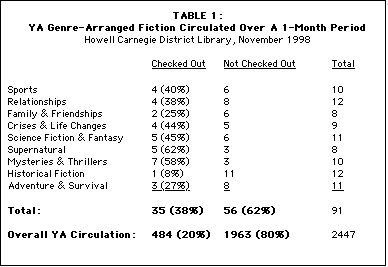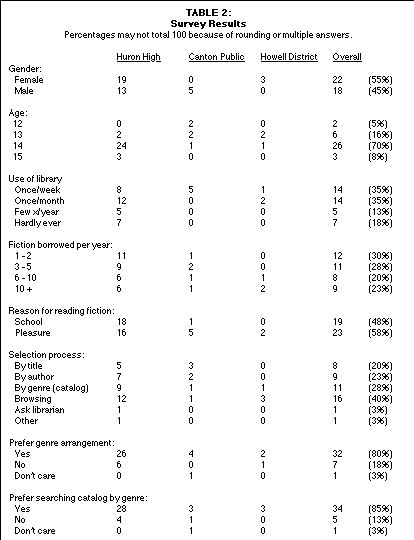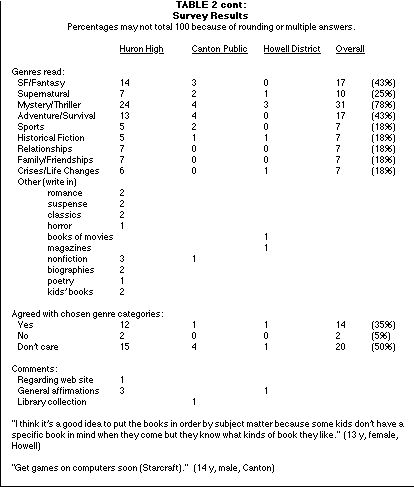
a study by Maggi Rohde
Anne Hoey
and Pamela Chamberlain
SI 666 Fall 1998
Introduction
Young adults are often thought to be underserved by public libraries.
Only 37% of all public libraries employ a librarian targeted at
serving both young adults and children, and only 11% have a young
adult librarian (Heaviside et al, 1995). This implies that a minority
of public libraries spend significant money or time on improving
services for young adults. Conversely, many librarians believe young
adults don’t take advantage of library services because of
competition from other, more attractive activities. Thus, to increase
YA involvement in libraries, the best course of action would seem to
be to make the YA collection as accessible and easy to use as
possible, without adding to the burden of existing staff or budget.
One way to do this is to organize the YA fiction collection by
genre.
Both early and recent studies on arranging fiction collections by
genre indicate that this type of arrangement both increases
circulation of books and is preferable to a majority of
patrons:
• In the only fiction classification study done on young adults, in a
junior high school library in California, 88% of students found the
classed system easier to use than the previous alphabetically-
arranged system (Briggs, 1973).
• The earliest study was done in 1902, in which a portion of a public
library collection was shelved by genre and circulation patterns
studied for two years. After the rearrangement, 57% of circulated
books came from the genre-arranged fiction, a significant increase
(Borden, 1902).
• One British study done in public libraries reports that 59% liked
having the fiction collection classed and shelved according to
genre, while only 24% wanted it classed and shelved alphabetically
(Spiller, 1980).
• In another British study, 79% of adult fiction readers preferred
having the fiction classed and displayed separately (Ainley and
Totterdell, 1982).
• After writing a review of all aformentioned studies on fiction
classification, Sharon Baker performed her own study on public
libraries, in which she found that separating fiction into classed
categories does increase circulation, by as much as 98% (Baker,
1988).
From this evidence it seems reasonable to hypothesize that:
• Arranging YA fiction by genre on the shelves will increase
circulation of those items, and
• YA patrons will prefer this arrangement to the previous one
(alphabetical by author).
The primary goal of our study was to test this
hypothesis.
Our study followed this course:
1. Create an organizational scheme that is appropriate for YA
fiction collections, based on existing studies.
2. Implement this scheme on a small scale in a public library in order
to test the hypothesis.
3. Evaluate effectiveness, usability and practicality of scheme based
on patron feedback, completed surveys and circulation data from the
public library.
Creation of an Organizational
Scheme
Before consulting the literature, we first sent a message to the
professional YA librarian’s email list (YALSA-BK) to ask for
success stories from librarians who had arranged their own
collections by genre. The responses were encouraging. Kate McLean
from the Tucker-Reid H. Cofer Library in Georgia said “I loved
it! It is wonderful for browsing collections. During that summer
[when my collection was arranged in this way] I do believe
circulation grew; no stats though.” (McLean, personal
communication, 1998) Lesley Gadreau of Seabrook Library in New
Hampshire provided us with her set of nine categories, along with a
suggestion to use a “secondary sticker” on the spine of the
book to indicate crossovers in genre, such as romantic historical
fiction, or humorous fantasy. She indicated that rearranging her
collection into genres has helped her patrons choose new authors to
read, which is one of the three fundamental purposes of
genre-arranged fiction schemes:
“I rearranged my YA fiction collection about two years ago into genres and my circulation has more than tripled.... [T]he arrangement of the books by genre helped kids be more successful in finding books and in moving from books they knew they liked to new titles and authors. My faithful R.L. Stine readers started reading Duncan and Lovecraft and Nancy Drew fans gave other mysteries a try.... I don’t regret the reorganization one bit.” (Gaudreau, personal communication, 1998)
We also received pointers toward studies on
fiction classification, such as Sharon Baker’s research from the
late 80’s.
No definitive research has been done to determine the ideal set of
categories for use in designing a scheme for classification of
fiction, but there are some basic principles behind the success of
such schemes. Sapp has made mention of the fact that using the Dewey
decimal or Library of Congress classification schemes for fiction are
too limited and restrictive to be useful in targeting these
principles (Sapp, 1986), and thus they were not consulted when
creating our scheme.
As outlined by Baker in her review article on fiction classification
schemes, the three main points are:
1. Fiction classification should make it easier for library patrons to find the
types of books they want.
2. Patrons select books in many different ways, including genre,
broad subject, format and literary quality; classification schemes should
take these multiple methods into account.
3. Fiction classification should also expose the patron to new authors.
(Baker, 1997)
Thus, in accordance with point 1, our scheme
included enough categories to appropriately subdivide the collection,
but not so many as would confuse patrons. Categories were not
subdivided below one level, again, for ease of use. To help fulfil
point 2, categories included both genres (i.e. mysteries) and
subjects (sports, adventure). However, we agreed to shelve the
classics and graphic novels in with the contemporary paperbacks,
rather than creating separate categories for them, as this would seem
to increase the likelihood that patrons would read different formats
and qualities of books. Lastly, point 3 was addressed in the fact
that our organizational scheme would be presented as a collection of
fiction shelved by genre, rather than labeled and shelved
alphabetically, as this former method of presentation has been shown
to increase the patrons’ exposure to new authors (Spiller, 1980;
Borden, 1902; Baker, 1988).
To select a set of appropriate categories, we turned to textbooks for
YA librarians (Jones, 1998; Arnold, 1998). We also consulted with a
YA librarian at Canton Public Library, Wendy Woljter, as well as
several librarians in other states who have arranged their YA fiction
by genre. Eventually we settled on this set of nine
categories:
1. Adventure & Survival
2. Crises and Life Changes
3. Families & Friendships
4. Historical Fiction
5. Mystery & Thriller
6. Relationships
7. Science Fiction & Fantasy
8. Sports
9. Supernatural
This set was broad enough to encompass all the
fiction we wished to include in our study without resorting to the
vague “General Fiction” category. We also purposely chose
the name “Relationships” instead of “Romance” to
see if that would draw a larger audience, but as the results will
show, this was probably a poor choice. “Supernatural”
defined the category of realistic fiction with a twist, such as
vampire and ghost stories, but which were not targeted at scaring or
grossing-out readers. “Crises and Life Changes” included
themes like death, abuse, sucide, racial tension, and abortion.
Implementation of Chosen Scheme
After confirming our organizational scheme, we chose a set of books
to fit these categories. Our first choices were books which were less
than four years old and had been favorably reviewed by ALA,
Booklist or another source. We used lists which we found on
the ALA web site and in profesisonal journals, as well as drawing
from our personal experience with YA literature.
In order to test our hypothesis, we worked with actual circulating
collections of books, as well as using an online simulation. We
contacted three libraries with which we had familiar interactions:
the Canton Public Library, the Howell Carnegie District Library, and
Huron High School.
Real World Testing. The Youth Services Coordinator at Howell
Carnegie District Library, Holly Ward Lamb, agreed to allow us to
pull a subset of her YA fiction collection to display in a
genre-arranged format for one month. We chose all the fiction which
was present both on our list and in the Howell collection, and then
supplemented with additional appropriate titles from the collection.
We labeled a final set of 91 books with colored stickers, one color
for each category, and shelved the set under a small legend for the
categories. After one month, circulation data for the genre-arranged
fiction was collected and compared to the overall circulation of YA
fiction in the Howell YA collection. Results are summarized in Table
1.

Online: A Simulated Browsing
Environment. Because we
would not be able to set up a similar physical arrangement of
books
at other locations, we created a web page which would help us
simulate the browsing environment a patron might encounter at
the library. This presented the patron with a bookshelf of
color-coded
books, on which they could click and browse through the books by
subject, looking at the covers (scanned photos of the books) and
reading the dust jackets (short abstracts). This “web
bookshelf” was
used both at Canton Public Library and at Huron High School; the
media specialist at Huron, Gail Beaver, employed a more
controlled
environment by guiding two freshman classes to the web page and
asking them for feedback.
Both settings were provided with a one-page survey to solicit
feedback. At Howell and Canton, the surveys sat out for patrons to
fill out as they chose. In addition to basic demographics, the survey
asked the following questions (see Table 2 for a summary of survey
results from the forty surveys which were returned and usable):
• How much do you read? How often do you use the library? Do you
read for pleasure or for school?
• How do you most often find fiction books at the library?
• Do you want your library’s YA fiction arranged in genre format,
rather than by author?
• Would you like to be able to search the computer catalog by genre?
• What kinds of fiction books do you like? (offering choice of genres)
• Would you have chosen the same names/types of categories that we did?
• Other comments, etc.
Results and Evaluation
The hypothesis presented in this study had two aspects. First, that
arrangement of YA fiction by genre, shelved separately, will increase
circulation of these items; and second, that the patrons of the YA
fiction collection will find the genre-arranged fiction easier to use
and preferable to alphabetically-arranged collections. We find, by
examining both the surveys and circulation statistics at Howell
Carnegie District Library, that both aspects of the hypothesis are
supported by our data.
The Howell data provides support for the first aspect. The percentage
of circulation across the entire YA collection was 20%, while
circulation of genre-arranged items was 38%. This is not a large
enough sample or an extensive enough study to give any truly credible
data, but it does correlate with previous literature: arranging
fiction by genre increases circulation of those items.
Data from the surveys support the second aspect of our hypothesis.
According to the survey, 80% of respondents would prefer to have the
YA collection in their library arranged by genre, as opposed to 18%
who like it the way it is. This is consistent both across frequent
library users and those who “hardly ever” use the library.
Anecdotal data from incidental browsers of the collection at Howell
also indicates that YA’s find genre-arranged fiction much easier
to use.
One reason given in the literature for the preference for genre-classed fiction is that of information overload in large collections. Patrons browsing in a large library often feel overwhelmed by too many choices, and this leads to a difficulty in making selection decisions (Baker, 1998). Genre classification helps decrease this confusion. Baker ascribes information overload only to users of large collections, however; one study shows patrons in a library with 4,700 books did experience information overload, but not in one with 1,700 books. Another study found information overload in a library with 6,000 books, but not in one with 2,500.
Obviously the question of “how large is
large?” is difficult to answer when considering the effects of
information overload. While the YA collection studied here has fewer
than 2,500 items, the question of the skill and experience level of
the patrons in making selection decisions must be considered. Young
adults between the ages of 12 and 15 are not as skilled at making
choices as an adult, and therefore the possibility exists that they
may experience information overload at much lower stimulus levels
than adults. It should be pointed out, for example, that shelving YA
literature apart from adult literature significantly increases its
use in all public libraries, no matter what size the YA
collection is (Heaviside et al, 1995). Further study is necessary to
address the question of information overload in young adults.


When considering what we might have done
differently in the course of the study, we first examine the surveys.
The focus of the survey was to obtain data about our population and
generally whether they preferred the genre arrangement over
alphabetical arrangement of fiction, rather than on whether this
arrangement would actually cause them to check out more books. In
this case, we felt it was more accurate to let the circulation
statistics determine whether or not patrons would truly cause an
increase in circulation, and have the patrons only give feedback on
their personal preference for a browsing display. However, it would
have been useful to include some questions about whether or not
patrons experienced information overload when dealing with
undifferentiated collections.
The names for categories used in the classification scheme proved to
be a bit confusing for some patrons. A few girls asked “What
about romance?” without making the connection to
“Relationships” as encompassing romantic literature.
Similarly, some patrons asked for “suspense” or
“horror,” feeling that our categories of
“Supernatural” and “Mystery/Thriller” didn’t
cover all the bases. Were we to revise the classification scheme, we
would probably rename the categories using the more customary
categories used by booksellers. In addition, we might choose to
combine “Friends and Families” and “Crises and Life
Changes” into a single category of “Realistic Fiction”
to make it easier for the cataloger. Finally, determining the
difference between “Supernatural”, “Science Fiction
& Fantasy” and “Mystery/Thriller” might prove to
be too complicated, and two of those genres would probably be merged
in some way. Further studies regarding genre labels for YA’s is
definitely indicated.
Ainley, Patricia and Barry
Totterdell. Alternative Arrangement: New Approaches to Public
Library Stock (London: Assn. of Assistant Librarians, 1982).
Arnold, Mary. “ ‘I Want Another Book Like...’ Young
Adults and Genre Literature,” Young Adults and Public
Libraries, Mary Anne and C. Allen Nichols, eds. Connecticut:
Greenwood Press, 1998, p. 11-22.
Auerbach, Barbara. “Hangin’ at the Library,” School
Library Journal 42:60, Jun 1996.
Baker, Sharon L. and Gay W. Shepherd. “Will Fiction
Classification Schemes Increase Use?” RQ 28:366-376, Spr
1988.
Baker, Sharon L. “Fiction Classification Schemes: The Principles
behind Them and Their Success,” RQ 27: 245-51, Win
1987.
Borden, William A. “On Classifying Fiction,” Library
Journal 27:121-24, Mar 1902.
Briggs, Betty S. “A Case for Classified Fiction,”
Library Journal 98:3694, Dec 1973.
Heaviside, Sheila, Christina Dunn and Judi Carpenter. Services and
Resources for Children and Young Adults in Public Libraries.
National Center for Education Statistics, U.S. Department of
Education, Office of Educational Research and Improvement, Aug
1995.
Gaudreau, Lesley. Personal communication, October 20, 1998.
Jones, Patrick. Connecting Young Adults and Libraries. New
York: Neal-Schuman Publishers, Inc. 1998.
MacRae, Cathi Dunn. “The Secret Lives of Teenagers,”
VOYA 21:168-169 & 175, Aug 1998.
Marshall, Margaret. Libraries and Literature for Teenagers.
London: Trinity Press, 1975.
Maughan, Shannon. “YALSA and Booksellers: Building A
Bridge,” Publishers Weekly 245:31-32, Jun 1998.
McLean, Kate. Personal communication, October 22, 1998.
Sapp, Gregg. “The Levels of Access: Subject Approaches to
Fiction,” RQ 25: 488-97, Sum 1986.
Spiller, David. “The Provision of Fiction for Public
Libraries,” Journal of Librarianship 12:238-65, Oct
1980.